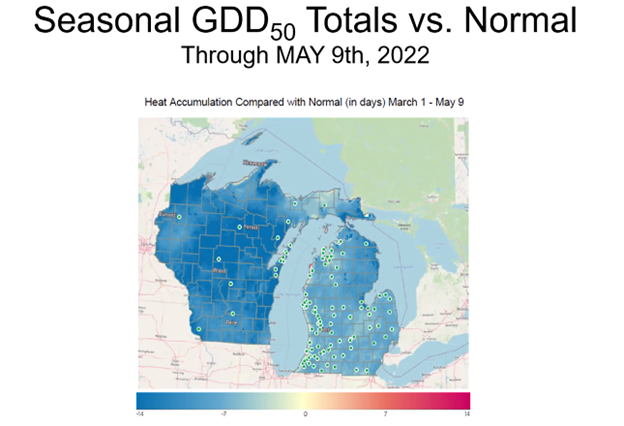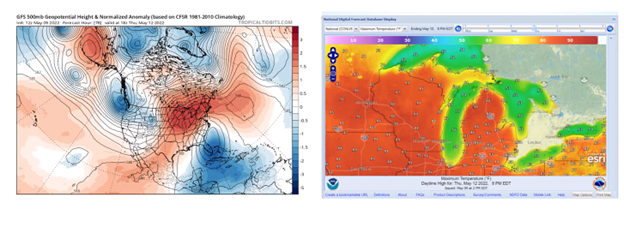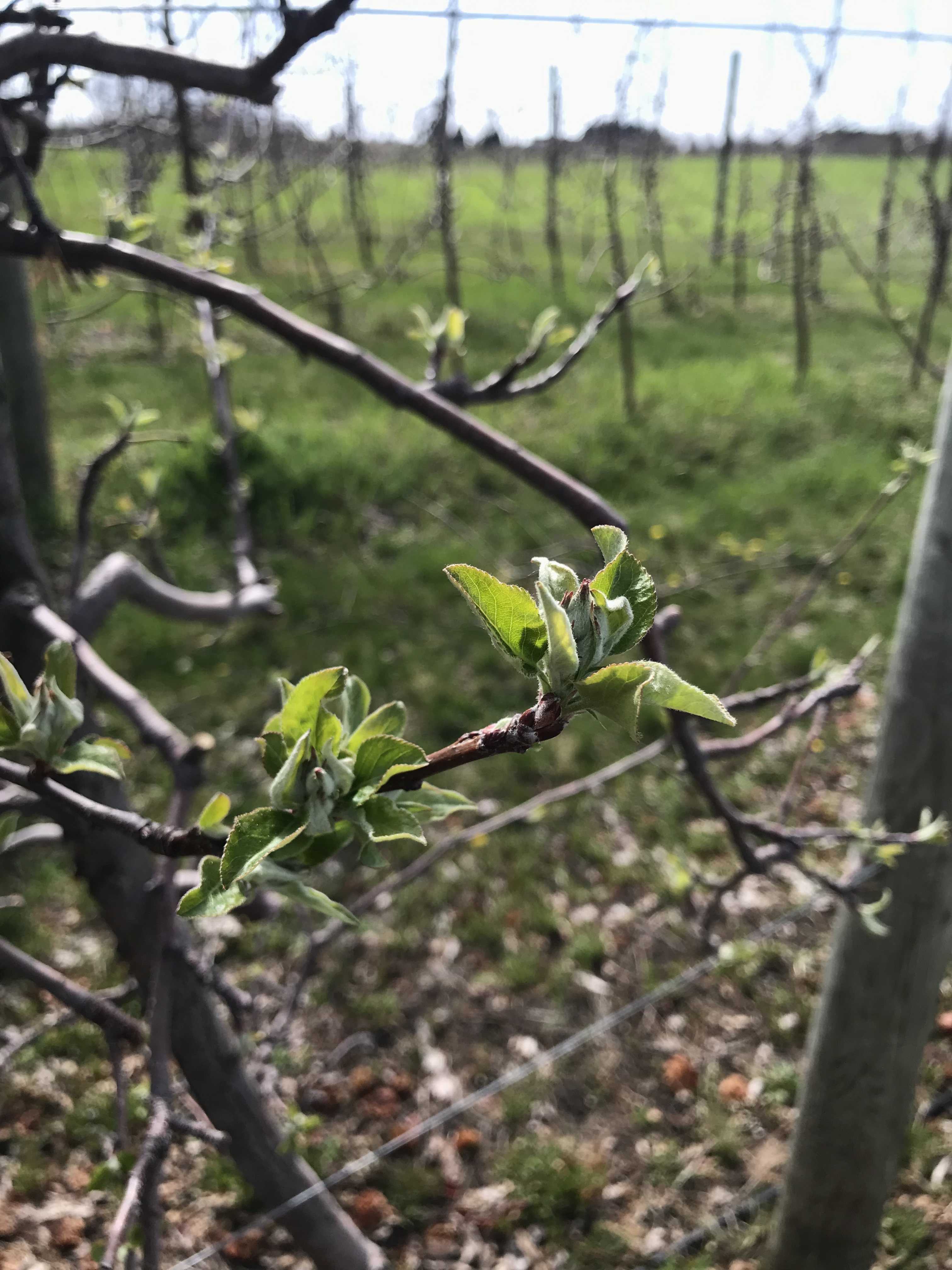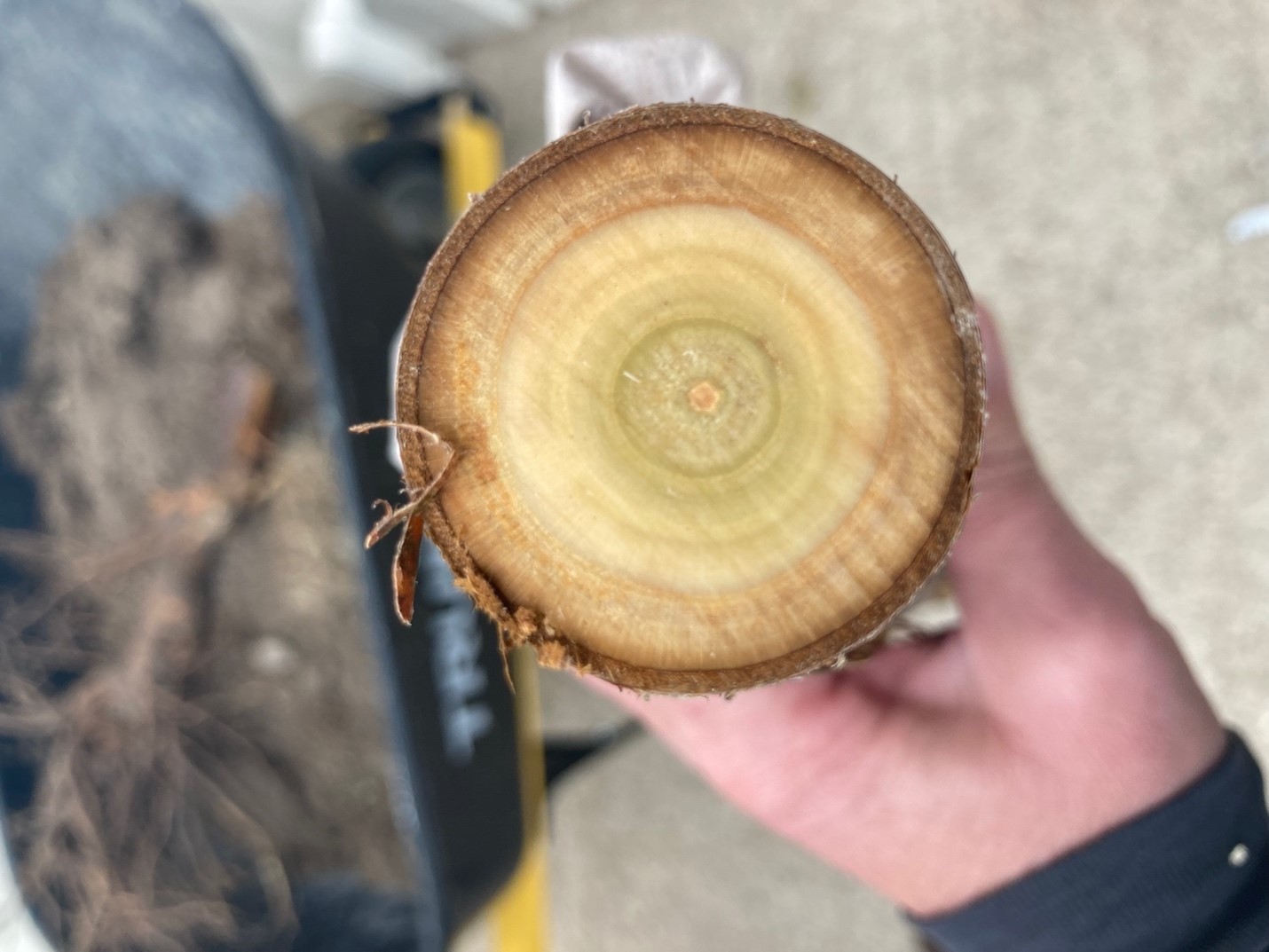Northwest Michigan fruit update – May 10, 2022
Weather has made a turn from cooler and wetter than normal to up to 20 degrees above normal temperatures. This warm weather will speed up crop development; watch for pop up rains and new green tissue that needs to be covered for diseases.

Weather report
The weather has changed dramatically over the past week. Our 2022 spring has been cool and wet thus far (Figure 1), but the recent warm weather has moved into the area and is forecasted to stick around through the weekend. We estimate that some of the warm daytime temperatures will hit into the 80s and maybe even hit 90 by Thursday or Friday this week; these temperatures are approximately 20 degrees warmer than our normal conditions (Figure 2). There is a ridge over the central part of the U.S. that is keeping the country above normal for the remainder of the week. Dew point temperatures will jump 10 degrees into this afternoon (May 10) and into tomorrow. High temperatures will be five to 10 degrees warmer than normal, and nighttime temperatures will remain higher than normal as well.
As of this morning, we have accumulated 212 growing degree days (GDD) base 42 and 83 GDD base 50. We are catching up to our 30-plus year averages compared to last week; we have accumulated 302GDD base 42 and 133.5GDD base 50.
The northern part of the state has been extremely dry following a wet March and a normal April. Coupled with the warm temperatures and high winds, our region is in a red flag warning period, which signals no one should be burning at this time. The southern parts of the state received some rainfall late last week, and some areas recorded up to 2 inches of rain, and rainfall totals are higher than normal in the south. There are some popup rain showers in the forecast, but they will be extremely variable across the region. Some of rains will not make it to the ground with the extremely dry air. The best chance of rainfall is in the western part of the state, and the chance for rain will decrease as clouds move to the east. Keep an eye on weather and popup rains to ensure new green tissue is covered for diseases like cherry leaf spot and apple scab.
The forecast is predicting a big cool down next week, and conditions will go back to normal or cooler than normal. Rainfall predictions are also anticipated to be spotty across the state.


Crop report

Crop development has moved with the recent warm temperatures. We are at early tight cluster in Honeycrisp, and tight cluster in Gala. We are at early bud burst in Montmorency and tight cluster in Balaton. All varieties of sweet cherry have a slight bit of white showing now, and growers on the east side are starting to see flowers open. Growers should be sure to have sprayers up and working and calibrated in case we see some popup rain showers.
We received a call about dead two and three-year old tart cherry trees where much of the entire block has or is expected to die relatively soon. This phenomenon is unusual, but according to past observations, we can see dying young tart cherries when we get a warm up then a cool down later in the winter once trees have achieved their chilling hours. We looked back at temperatures on Christmas Day, where we recorded a high of 43 F, and by Jan. 11, temperatures had dropped, and we recorded a low temperature of 7 F and a high of 10 F. Again, this situation does not happen often, but we have observed blocks of dead Montmorency when they are in the 2–4-year age range. The damage appears to be in the xylem tissue. However, when we cut these trees across the trunk, we observed more traditional winter injury (Figure 3). There was a cold period in early December where we got down into the teens.

Retain. Sweet cherry growers, especially on shy bearing varieties, should be considering Retain applications to increase fruit set and ultimately increase their yields. ReTain is a plant growth regulator that has been shown to extend flower viability in cherries by reducing ethylene production in cherry flowers and delaying flower and stigmatic senescence. Due to this effect, flowers that last longer have a higher likelihood to be successfully pollinated, and increased pollination results in a higher yield. Research has shown that ReTain works best if used before poor pollinating conditions, including wet, cool, windy weather or low honey bee activity, or on varieties that tend to be shy-bearing.
Michigan State University Extension recommend that ReTain be sprayed early in the season, either popcorn or first bloom. The rate of ReTain is one pouch per acre (11.7 ounces per acre); some growers have used two pouches per acre to ensure adequate yields. The more tissue on the tree, the better the response, but the key timing is early based on our results and past recommendations by the Valent Company. The spray volume is recommended at 100 gallons per acre. ReTain cannot be used after petal fall, and it is not recommended if rain is expected within eight hours of application. Temperature should be monitored during application timing as the effectiveness of plant growth regulators decrease at low temperatures. Also, we recommend applying ReTain under slow drying conditions. According to the Valent representatives, they have found that treating a larger block is more effective than treating rows within a block; the overall effectiveness of the active ingredient in ReTain is improved with broad coverage.
Insect pest report
Green fruit worm. We still have not caught a lot of insects in the trap line with the cool weather, but with the warming conditions, we anticipate that we will see an uptick in insect activity. We caught an average of 12.6 green fruit worms moths this week.
San Jose scale. Some growers have been battling San Jose scale infestations in sweet cherry for many years. We have been recommending a dormant oil spray to smother the overwintering scale insects on the trees, and some orchards may be approaching windows that are too late for these dormant oil applications. If you missed this dormant oil spray, we recommend waiting until leaves are out further to better uptake other scale materials such as Movento, Sivanto, Centaur. We are no longer able to use Lorsban in the tank mix for control of San Jose scale as this product use has been discontinued as of February 2022. Lorsban is not allowed for use of San Jose scale control any longer. Therefore, growers that have had San Jose scale in the past should be sure to apply oil this season to get a jump on controlling this difficult pest. There are no frost or freeze events in the forecast, and growers should make their oil applications as soon as possible if the warm weather causes sweet cherries to develop quickly (too much green tissue) beyond the time frame where oil is still safe to use.
Black stem borer. We have not trapped any black stem borer yet this season. However, they are starting to catch beetles down state at this time. Growers that have had issues in the past should be monitoring for this pest or using this report to help gauge early season control options.
Honey bee health. Although our region is still out a bit on apple development, consider pink applications. Remember that we cannot use Lorsban in orchards this season, and on many farms, a Lorsban application at pink was the standard. There are many other options if you are looking to control aphids, such as a reduced risk option like Sivanto. Avoid using microencapsulated insecticide products around bloom time as they have been associated with honeybee dieoff.
Disease report
American brown rot. Blossom blight control for American brown rot will be important with warm temperatures, particularly if we get some rain. The potential for blossom infection in Michigan is typically held in check by cooler weather as the optimal temperature for infection is between 72 and 77 F, and spore production is greatest between 59 and 74 F.
The best fungicide for American brown rot management during bloom is the dicarboximide fungicide Rovral. This is an effective American brown rot material during bloom because inoculum levels are lower and can be controlled. Also, since this fungicide has a different mode of action, it is an excellent alternate tool for fungicide resistance prevention. A maximum of two applications of Rovral can be used, and do not use this fungicide after petal fall. Consider Rovral applications prior to this petal fall timing.
Cherry leaf spot. Bract leaves are not yet open at the research station, but keep in mind cherry leaf spot applications to control this fungus from infecting open stomata on bract leaves. In wet springs, we are recommending early season leaf spot applications to minimize potential for epidemic levels of this fungus in the orchard. At this time, weather is predicted to be dry through the week with only potential for popup showers that may be variable throughout the region.
Apple scab. With the recent warm up, we are starting to see more green push, and Galas at the station are at tight cluster. Be ready to make apple scab applications to cover new tissue if we do receive some rain. Monitor weather forecasts to be prepared to cover for scab. The RIMpro model is showing apple scab maturation with the warm weather (Figure 4) as well as a high to extreme high infection period if we do get rainfall today, May 10. There is another potential infection period on May 15. EBDCs are good products to be used early in the season as they have long PHIs.

Powdery mildew. The powdery mildew fungus grows when conditions are warm, and this forecasted weather is a reminder to be thinking about powdery mildew programs early this year. Additionally, this fungus can infect leaves without moisture, such as dew or rain, and again, forecasted conditions may be conducive for this disease to develop. Apple powdery mildew is caused by the fungus Podosphaera leucotricha. This fungus grows as a white mass on new terminal growth of trees, and these symptoms can result in loss of vigor and potential effects on return bloom and yield of bearing trees and stunted growth of nonbearing trees. In addition, powdery mildew infection of fruit can cause russeting if the disease is not controlled before fruit are present. The peak risk for mildew infection is right after petal fall, which coincides with rapid leaf growth of trees.



 Print
Print Email
Email
